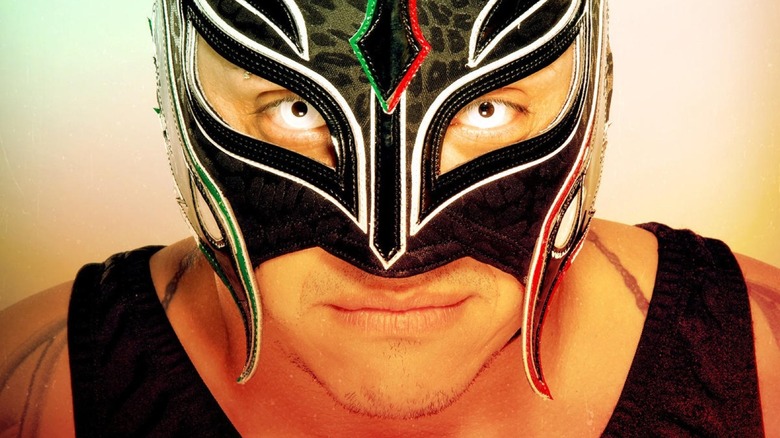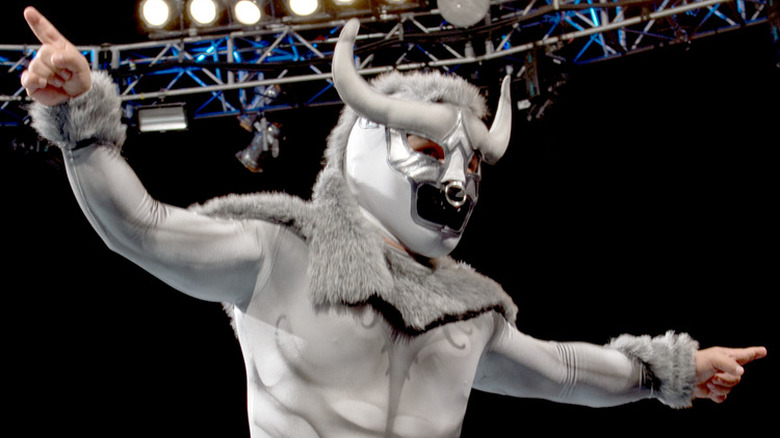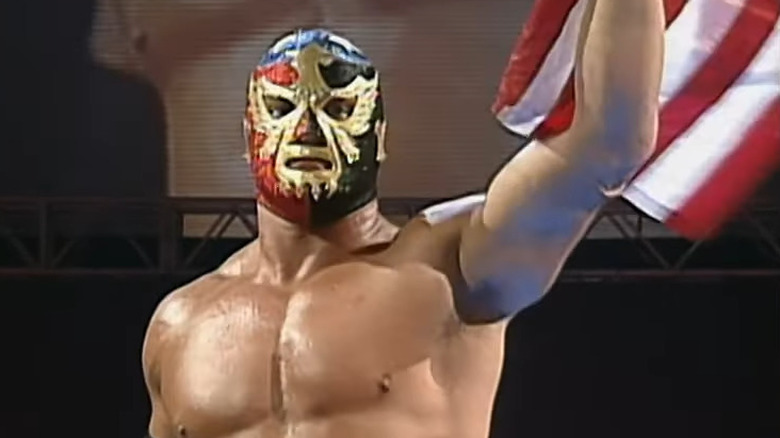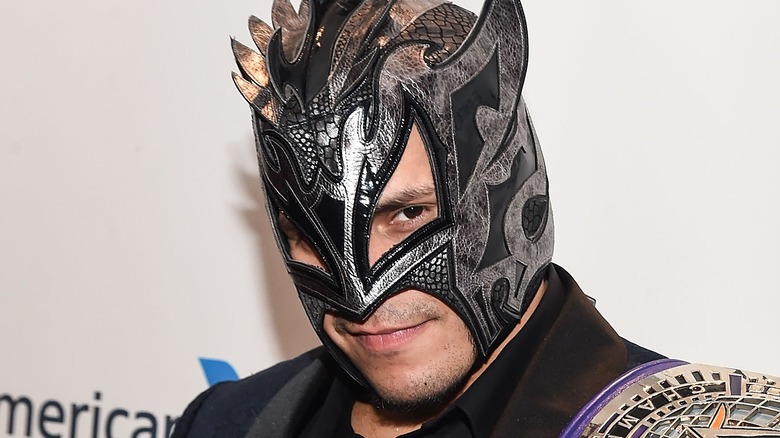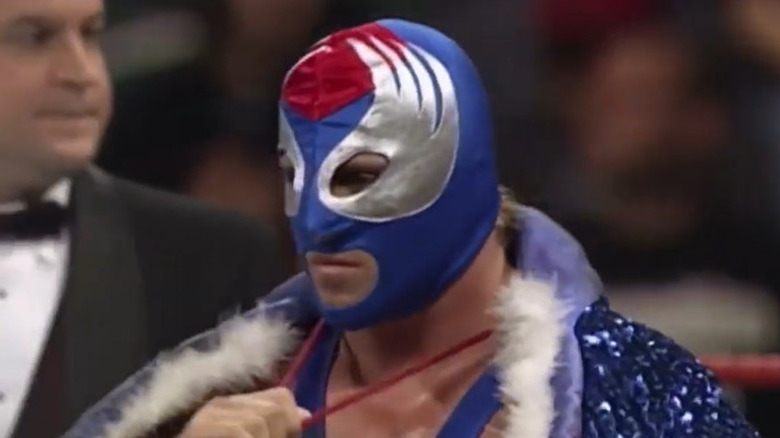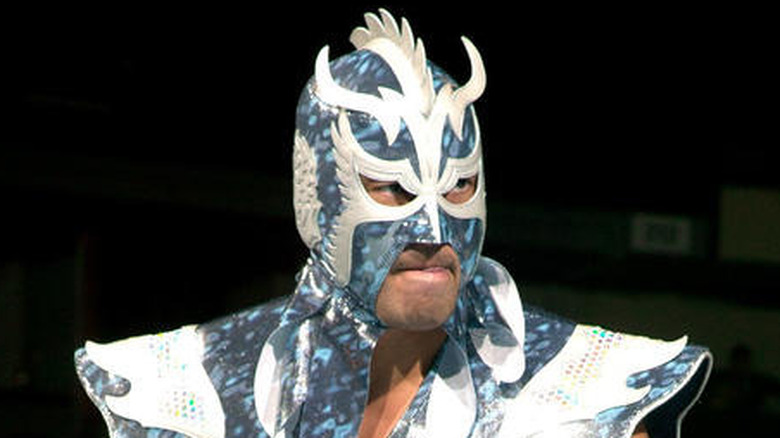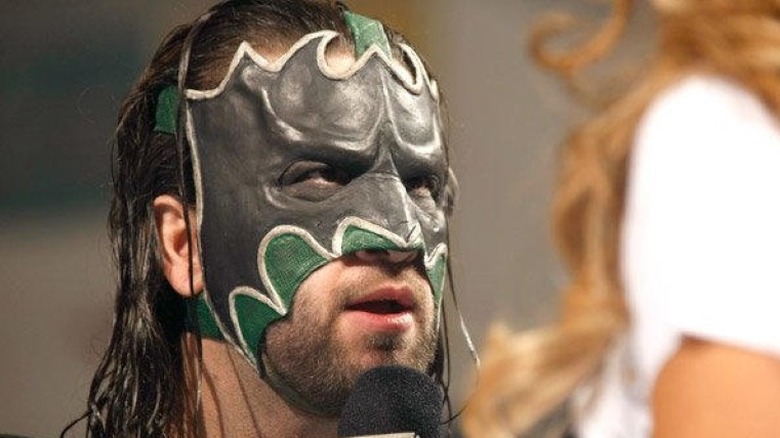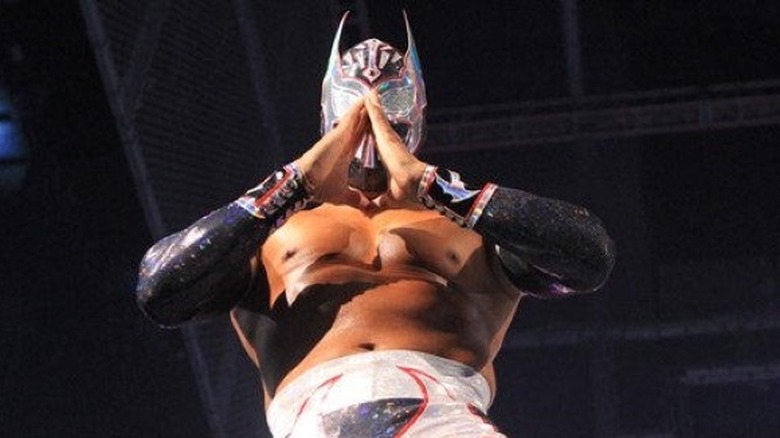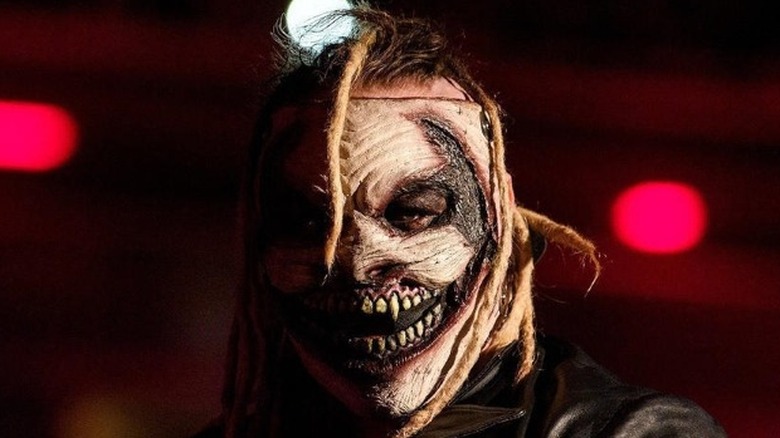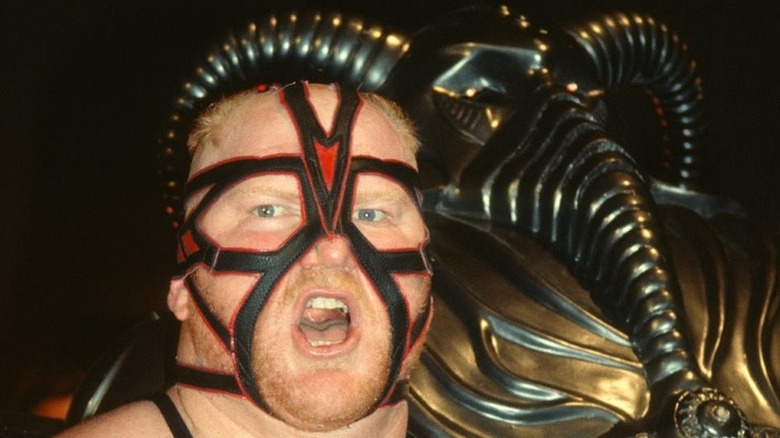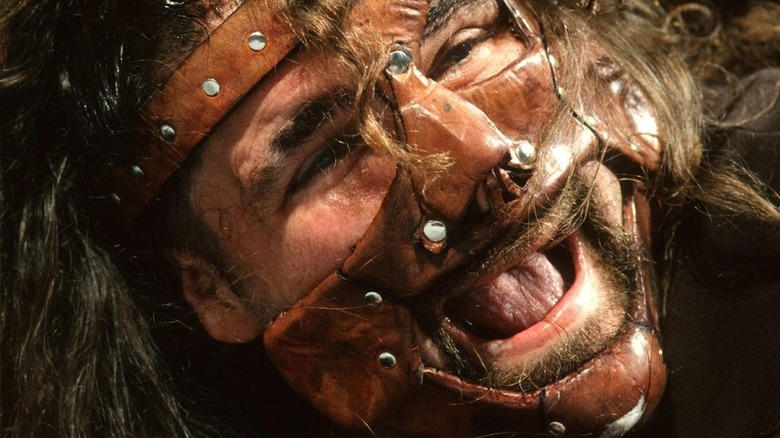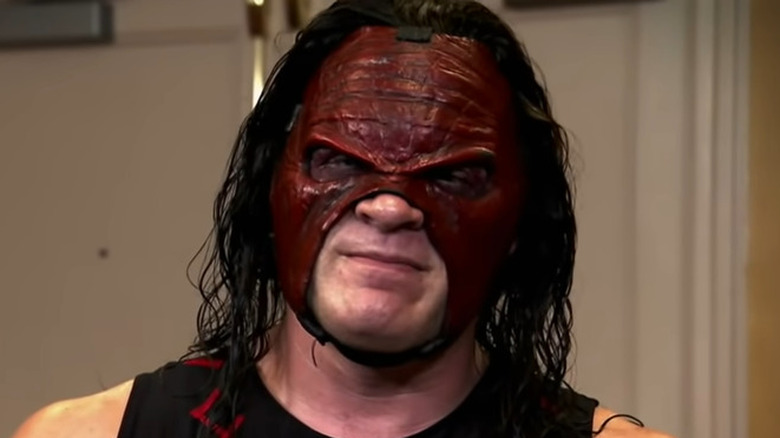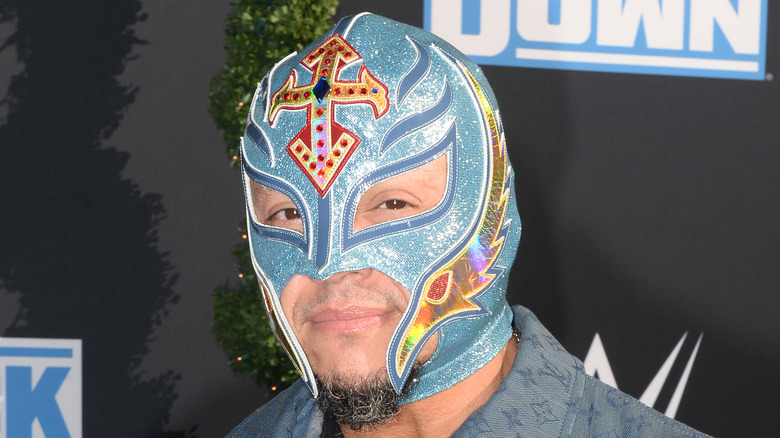The 12 Most Successful Masked Wrestlers In WWE, Ranked
It is widely believed that wrestling masks got their start in 1865, when a French circus performer named Theobaud Bauer donned a face covering and became "The Masked Wrestler." Fast forward a few decades, and we arrive at Mort Henderson, the first American to go masked and transform into "The Masked Marvel." Today, we have entire businesses dedicated to the masked pro wrestler. Each mask is a work of art featuring intricate leatherwork and sometimes huge horns and teeth. The masks' legacies that often outlive the performers underneath.
While masked wrestlers have long been some of the most famous wrestlers in Mexico and Japan, the masks haven't been as easy to popularize in the United States. Part of this was due to an obscure New York law that kept professional wrestlers from performing under a mask in that state, meaning there weren't any big name luchadores heading to Madison Square Garden. That changed in 1972 when WWE was able to get the law overturned, allowing the legendary Mil Máscaras to perform in a series of matches against "Superstar" Billy Graham.
WWE has had a number of successes over the years when it comes to mysterious masked wrestlers; today, we look at the 12 most successful of those performers.
12. El Torito
El Torito, or "The Little Bull," was the sidekick/mascot of the tag team Los Matadores from 2013 to 2015, and he was with WWE another year after that, usually feuding with his former partners. Torito was a beloved, wildly popular performer, getting crowds to cheer enthusiastically as he ran around the ring providing a distraction for his bullfighting friends while pantomiming bull attacks directed at their rivals. He was the best part of this, or any, version of the Colons (the wrestlers under the matador masks), and El Torito is likely the most popular little person performer in recent American wrestling programming not named Hornswoggle.
While Torito's run in WWE wasn't the longest, his career outside of the fed has lasted over 20 years. Currently performing as Mascarita Dorada, he has been active on the independent scene for years since his 2016 WWE release, most recently appearing at a show at the Lucha Bros' Republic of Lucha store in Los Angeles. Even though matches involving "minis" or "mini-estrellas" are featured less and less on cards elsewhere in the world, they are part of their own legitimate competitive divisions in Mexican promotions CMLL and AAA, and have been performing in front of crowds for decades. Since thriving in the '50s and '60s using the same carny formula that has gotten wrestlers over since the beginning of time, this division was and continues to be a fun, albeit very different, version of our favorite art form.
11. Patriot
After his legendary match with "Stone Cold" Steve Austin that cemented Austin as the beloved anti-hero of WWE, Bret Hart got comfortable with his role as a pro-Canadian, anti-American heel. Hart needed a rival, and with Hulk Hogan working for WCW at the time, another ultra-patriotic opponent would be ideal. Enter Del Wilkes, a guy who had worked in several other promotions after a successful college football career. His Patriot gimmick got him over in both singles and tag team action in WCW, New Japan, and the AWA, and he had a brief stint in WWF in 1991 as well. The flag wearing American with the eagle and stars mask was a perfect match for Hart's loathsome Canadian, and a win over the legendary Hart on "Raw" made the Patriot look like a legitimate threat.
Patriot was quickly built up from his second WWF debut in a late June dark match to a pay-per-view match for the WWE Championship in September of 1997. While he wasn't successful, he never looked bad in the title bout against Bret Hart. Patriot teamed with Big Van Vader against Bret and the British Bulldog on the next month's PPV show, but they lost that match as well. Unfortunately, his white-hot run burned out as quickly as it started, and Patriot was released in 1998 after a handful of post-Bret matches.
10. Kalisto
A veteran of Mexico's AAA promotion and several American independents before WWE, Kalisto was born in Chicago's Pilsen neighborhood but raised in Mexico City. He was a fan of the lucha libre style from a young age and began wrestling professionally at the age of 20. Kalisto signed with WWE in 2013, having a successful partnership with Sin Cara on NXT as the Lucha Dragons culminating in an NXT Tag Team Championship. Sin Cara and Kalisto would separate, and Kalisto saw success as a singles competitor for a while on the main roster, winning the United States Championship twice, and later the Cruiserweight Championship. Kalisto later joined up with Lince Dorado and Gran Metalik to form the wildly popular (if not terribly successful) Lucha House Party. They evolved into a fun-loving faction that kept the catchy theme music and "Lucha! Lucha! Lucha!" chant from the Lucha Dragons' entrance but added a colorful mascot and noisemakers.
While all three members of Lucha House Party (four if you count Penelope the piñata) were beloved, only Kalisto was a true singles superstar. Even so, the unique designs for each luchador's mask allowed them to be easily recognized during their matches. Lince Dorado's golden lynx mask featured pointed ears on top and a fuzzy mane on the sides, Gran Metalik had sharp edges built into his face design, and Kalisto's mask had a unique dragon-like triple fin design on the top of his mask. While all of these amazing performers have moved on from WWE, they continue to perform today.
9. Blue Blazer
Owen Hart's alter ego, the Blue Blazer was a comic book superhero type, a guy that could beat midcard wrestlers while not quite being able to ascend past that spot on the card himself. Despite Owen's family name and obvious in-ring skill, WWE chose to debut Owen under a mask when he first signed with the company in 1988. That first run with the company ended after only a year, although the Blue Blazer did manage to work himself onto WrestleMania V with a match against Mr. Perfect.
After a return to the WWE in 1991, Owen had a fantastic career. He was a four-time tag team champion, a European Champion, and won the Intercontinental Championship twice. He had historic storylines as the King of Harts and as a member of the Nation of Domination while also showing the world his incredible in-ring ability, finally able to work without the lingering shadow of his brother hanging over him. However, in 1998 a storyline was presented that led to Hart "quitting" the WWE again, only to return in the mask of the Blue Blazer. It was presented as more of an over the top, arrogant heel character, more in line with the persona Owen was playing. While he did have some good matches under the mask, that final run as the Blue Blazer is mostly remembered for its tragic ending.
8. Ultimo Dragon
The bearer of one of the coolest cowl/mask designs ever and the innovator of several wrestling moves that were way before their time, Ultimo Dragon was an amazing WWE superstar with a legendary pedigree that he earned far before he ever set foot in America. A trainee of the New Japan Pro-Wrestling dojo, Ultimo Dragon would learn his craft in Mexico after he was told he couldn't compete in NJPW due to his size. His title history is basically a look at the history of cruiserweight and light heavyweight wrestling. At one point, Dragon held ten titles simultaneously, making him a belt collector the likes of which Kenny Omega could only hope to match.
Ultimo Dragon's WCW career was during the height of the cruiserweight division's popularity, but an injury sidelined him until he signed with WWE in 2003. While he had a memorable pair of rivalries with Rey Mysterio and Tajiri, at that point in his career he had lost a step. Still, the respect Ultimo Dragon has earned through his years of competition cannot be denied. Every time a Dragon Sleeper, Asai Moonsault, or Dragon Suplex is used it is a direct result of this legendary masked superstar.
7. The Hurricane
At the height of his popularity in WCW, Shane Helms was a member of 3 Count, a heel stable and parody of popular boy bands like *NSync and the Backstreet boys. When the WWE purchased WCW, Shane took the opportunity to rebrand himself, and on the August 21, 2001 episode of "SmackDown" a debuting Hurricane defeated Matt Hardy to become WWE European Champion. His character work was fantastic and his moveset was adjusted to match his oversized persona. Hurricane frequently used a chokeslam to finish opponents, typically a finisher for a much larger wrestler but one that fit the superpowered comic book hero persona.
That debut kicked off a very successful run for the heroic Hurricane. He won the WWE Cruiserweight Championship three times and the World Tag Team Championships twice, in teams with Kane and his superhero sidekick, Rosey. That's right — on top of being a successful competitor, the Hurricane managed to use his powerful character to inspire two more superheroes in the WWE: the aforementioned Rosey, and Molly Holly. Rosey was a member of the violent tag team 3 Minute Warning, but Hurricane saw the potential for good in him and made him his Super Hero In Training. Molly Holly abandoned her family to join Hurricane's quest for justice as Mighty Molly, donning a similar cape and costume style. These days, the Hurricane is disguised as Gregory Helms, backstage producer for WWE, although he breaks out his superhero gear for the occasional Royal Rumble match.
6. Sin Cara
Sin Cara had an interesting (and confusing) history in WWE, but the dramatic presentation of his entrance cannot be denied. The lights turn blue and gold, dramatic drums begin to beat, and the faceless man known as Sin Cara enters the arena to a pop of pyro and a burst of blue smoke. He runs to the ring and flies about five feet over the top rope to enter the squared circle, and the match is ready to begin.
Sin Cara was a hugely popular luchador in Mexico's CMLL promotion where he performed as Mistico. He signed to WWE in 2011 and debuted shortly thereafter, saving Daniel Bryan from an attacking Sheamus. A WWE wellness program violation led to Sin Cara's suspension. When he returned, he was portrayed as a heel, and the performer under the mask was not the same man. WWE decided to go with a developmental talent and begin a confusing storyline involving the original and replacement Sin Caras (Sins Cara?) that culminated in a mask versus mask match in Mexico City. While the original Sin Cara was victorious that night, he would only stay with the company another couple of years. Since WWE still owned the character, they decided to put Hunico, the replacement Sin Cara, back under the mask as the only Sin Cara in WWE. That version of the character was a longtime member of the WWE and then-new NXT rosters, and won the NXT Tag Team Championships with Kalisto as the Lucha Dragons.
5. The Fiend
Bray Wyatt has always been a master at creating new characters and fascinating backstories for them. In 2019, his run as the Fiend was one of the most memorable debuts of a new character in recent history. The Fiend is monstrous — his evil clown-like mask and striped pants, the lack of verbal communication, and his entrance all make him a twisted version of Wyatt's original persona, and the combination worked to create a truly unsettling persona. Add the Fiend's alter ego, a Mister Rogers-like Bray Wyatt talking to viewers from his twisted Firefly Funhouse, and it was a perfect horror character presentation.
If there was a popular criticism of the Fiend, it was in his booking. Fiend won the WWE Universal Championship twice, but the character never really needed a title as motivation. His matches were intense, but his most infamous was a Hell in a Cell battle with Seth Rollins that involved the ring area getting bathed in red light and a questionable referee stoppage. His supernatural ability to withstand pain led to confusion when he lost matches, because there wasn't a reason he shouldn't be able to recover when hit by a Goldberg jackhammer. In an interview with Ariel Helwani of BT Sport (h/t Fightful) Rollins mentioned how difficult it was to work with the Fiend's lore, saying "It was tough figuring out how to tell a good wrestling story with that character." Still, the overall reaction to the Fiend was positive and fans are waiting excitedly to see what Bray Wyatt brings to whatever project he appears in next.
4. Vader
Big Van Vader was an intimidating monster, a giant of a man with surprising agility and the toughness of a two-dollar steak. His smoking mastadon mask instilled terror in his victims, and the leather strap mask he wore during matches almost looked like it was holding his power and rage in check. Sure, other big men have often been called the biggest and the toughest, but did they have their nose broken before a match via a Stan Hansen bullrope? Did they then continue with the match only to have their eye popped out of its socket, then decide the best way to continue was to pop said eye back in? Did they then continue the match to its conclusion, a fifteen-minute double count out? No, no they did not.
By the time the Mastodon made his way to WWE, he was already a multi time champion who had competed in Japan and Mexico as well as, more recently, WCW. A debut in the Royal Rumble was the kind of thing people dreamed of, and Vader facing off against Yokozuna was a memorable start to the man's WWE career. Unfortunately, his WrestleMania program with Shawn Michaels didn't go as planned, and after Michaels audibly berated Vader during their match at SummerSlam 1996, Vader's career never really recovered. He did have great feuds with The Undertaker and Kane, among others, and lost a mask vs. mask match against Kane towards the end of his meaningful WWE career in 1998.
3. Mankind
Mankind was a lost and tortured soul that was born in a boiler room and wore a leather mask to cover his face. His mask mirrored his mind, twisted and gnarled, misshapen and warped. Mankind debuted in WWE in 1996. Originating from one of the greatest wrestling minds of all time, Mankind was created by Mick Foley as an alternative to the Cactus Jack persona he had used elsewhere. In an interview with "Talking Tough," Foley said that Vince McMahon wanted to cover Foley's face because he "didn't look like a star," and complained that the mask "really constricted my breathing." Mankind, despite having those setbacks from the start of his WWE career, managed to become a mesmerizing presence. His strange gait, awkward mannerisms and vocalizations, and willingness to do anything in the ring led to some of the most memorable matches of all time.
As Mankind, Foley won the WWF Tag Team titles six times, the Hardcore Championship once, and the WWE World Heavyweight Championship three times — including the time WCW attempted to minimize Foley's achievement, which indirectly led to WCW's demise.
In that "Talking Tough" interview, Foley talked about the amount of work he put into making Mankind: "So, I was able to inject a lot more realism into that character and it really was the best thing that could have ever happened to me ... Most of the time, you're doing your best at portraying a character and you're waiting for those few golden moments where you are that character."
2. Kane
An example of WWE being able to pull off both horror and long-term storytelling, the legend of Kane was drip-fed to audiences starting in mid-1997. Undertaker's then-former ally, Paul Bearer, was offended that the Undertaker was no longer interested in his services. Bearer revealed that Undertaker's father was a mortician, and Undertaker burned the mortuary his family lived in, with the family still inside. But a brother that was never mentioned before, Kane, somehow survived. Kane himself would debut in the Undertaker's Hell in a Cell match against Shawn Michaels at Badd Blood, tearing off the cell door and performing a Tombstone Piledriver on his brother.
Kane became a mainstay on the WWE roster, having a career that has spanned over 30 years and numerous character changes. He's been a heel and face, and an unlikely tag team partner to the likes of X-Pac, The Hurricane, and Daniel Bryan. He has teamed up with and fought against the Undertaker countless times. He's also won a ton of gold, including 12 different tag team championship victories, a WWE Championship, and a WWE World Heavyweight Championship. While he did eventually drop the face covering and even went corporate for a time, the bulk of Kane's reign of terror was under that ever-evolving red and black mask. Whenever he makes an in-ring return for a Royal Rumble or one-off appearance, odds are he will do so with the mask that made him a legend.
1. Rey Mysterio
A man who literally refers to himself as the "greatest mask of all time," Rey Mysterio has made the case for himself everywhere he's ever wrestled. While his claim is arguable, his achievements in WWE and beyond are not. Rey's career is the stuff of legends, and his current run is a testament to his ability to perform at a high level and adjust his moveset to his abilities. He has held gold in the WWE 15 different times, at all levels. He's also a perpetual underdog, as he only stands 5'6". That alone makes for some visually striking matches when Rey is pitted against the likes of Big Show, Kane, and Batista.
Rey Mysterio had so many attributes that WWE and Vince McMahon generally dislike, but Rey's attitude, high flying moves, and his ability to win over crowds was enough to overcome those issues. It didn't hurt that his mask was incredibly marketable, and he spoke to Sports Illustrated about the legacy he represents with it. "The mask defines me," Mysterio said. "It teaches you how to stand out. I'm happy that people can share in that joy and history and meaning. Now the mask is my trademark, universally related to Rey Mysterio. I can't wait for the day that I can pass it on to my son." Speaking of his son, he recently achieved another milestone in his iconic career — Rey and Dominik Mysterio became the first father and son to win a WWE Tag Team championship together.
